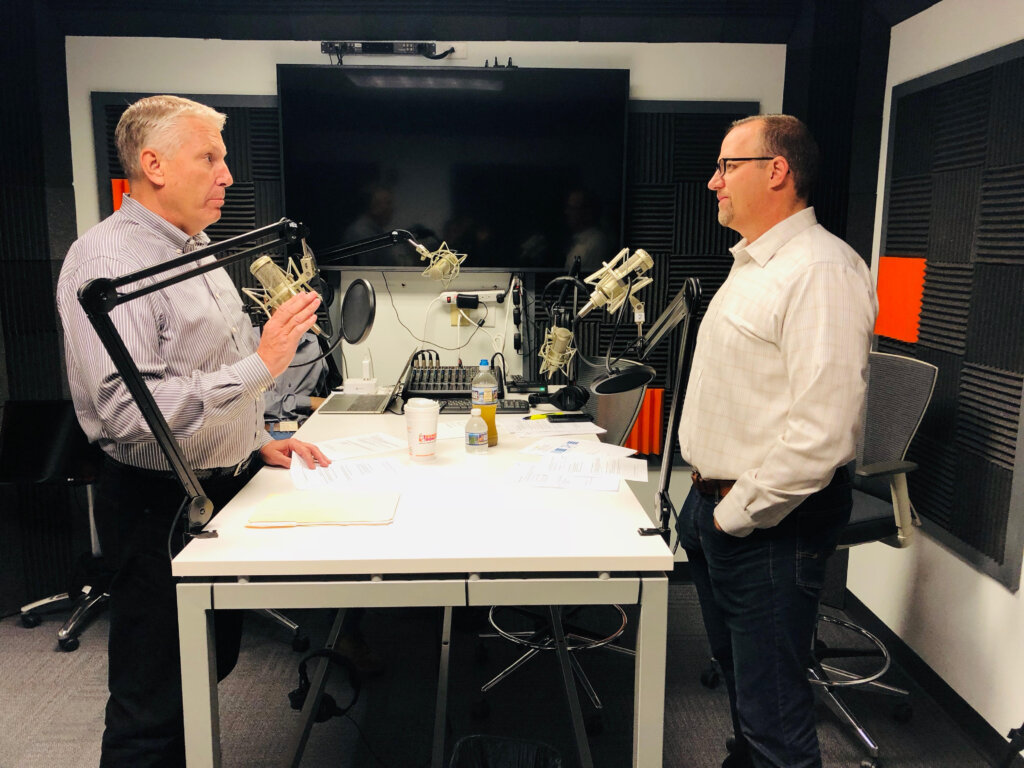Maxwell Executive Leadership Podcast #20: Increasing Engagement, Establishing Boundaries

One of the most important things leaders can do when bringing their teams to full engagement is establish boundaries. Although most people often have a hard time saying “no”, setting clear boundaries as a leader and for your team is key to increasing your organization’s overall engagement level. Episode 20 in our Executive Leadership Podcast will explore strategies for examining your team’s engagement level and where there might need to be a boundary.
Listen to all podcasts in this series and subscribe to new episodes on iTunes– or Google Play.
Read the transcript below:
Welcome to the John Maxwell Company Executive Leadership Podcast where our goal is to help you increase your level of influence, increase your reputation as a leader, and increase your ability to fully engage your team to drive remarkable results. Hi, I’m Perry Holley, a John Maxwell Company facilitator and coach and I’m Chris Goede, Vice President of The John Maxwell Company. Welcome and thank you for joining.
We’re continuing a little discussion on increasing engagement, one of the real challenges most leaders have about bringing their teams to full engagement. This podcast is titled: Increasing Engagement, Establishing Boundaries. I love this topic and I think as we’re really leaders overlook the positive effect on employee engagement, of being able to establish boundaries. Tell me what your thoughts are on boundaries when it comes to leadership.
I think boundaries are something that’s extremely important to a leader, especially for yourself, but also your team. I think it’s one of the things that if you don’t set properly, decrease the engagement level of your team. And so I thought, let’s talk a little bit about how does a leader go about establishing boundaries for himself and even for the team. And I know that Dr. Henry Cloud and has written on boundaries and there’s two things that I took away from there that I think he mentioned a lot of is what you pay attention to? And then the second thing he talks about what you inhibit, right? Or you hinder or you prevent. And in there I think he uses an illustration of talking to some parents about their son and going through kind of a decision making filter and what are the boundaries. And they didn’t even realize that they didn’t have boundaries. And so if you think about a fence around the backyard as an illustration. Inside that fence is mine outside that fence is someone else to bring this kind of even to life, one of the things that we talk about with our kids and leading our home and leaving them is we talk about staying in your yard. And even when you’re young, you tend to drift into other people’s yards. And so I have an 18 year old son and a 16 year old daughter right now. And it will be in a tense moment conversation with maybe my 18 year old and the 16 year olds jumping in or the 18 year olds jumping on some of the 16 were like, no, no, no, no, no, stay in your yard right here. That’s not your yard. Mom and Dad will help you with your yard when it comes time, and so we began to set boundaries. And I think it’s extremely important that for yourself in what you do on a daily basis for the organization, but also your team that you have proper boundaries set.
Yes. Well, Dr. Cloud’s work. It started with just Boundaries was the title, then he went into Boundaries for Leaders and it really got my attention when he said, like you said, well, what is a boundary? What, what you pay attention to things, pay attention to an and don’t pay attention to or inhibit. But he made a comment that said, what’s going on for you today? If it’s great and you’re hitting home runs every time, or if you’re struggling is because of two things, what you created and what you allow. What I’ve created and what I allow to be. So, I mentioned, as I read the title about boundaries and increasing engagement, I was wondering how you see, what is it about boundaries, establishing boundaries, understanding boundaries that, what does that have to do with the increase engagement of my team?
Well, it goes back to the kind of the fence illustration. We talk about men. If you don’t have a structure, you don’t have guard rails. You know that fence. It’s kind of like wide open. Everything is in play. Whether it’s other leaders in the organization coming to your team members and they don’t have boundaries. Whether it’s you helping other cross-functional different things at different times. You’re not supposed to be. All these different things are going to happen if you don’t necessarily have kind of a fence or boundaries and everything becomes into play. And so I think what we’ve got to do is we’ve got to make sure, it’s funny because I’m stating this and we have a, we have a struggle at the John Maxwell company doing this, but you’ve got to help your team and your priorities, make sure you stay focused to them.
John is an opportunity guy that likes to add value to everybody and sometimes we get off of that and it becomes wide open and we don’t necessarily have the right boundaries to stay focused. And so in order to do that, you’ve got to have repetitive communication and create clarity for your team on what they need to be focused on and what you need to be focused on. The other thing is we have to help them with their priorities. They have to understand what they need to be focused on. Are they focused on the right things? Another illustration, talking about fences, I heard someone share one time, you may know where this came from and they said, hey, it’s better to build a fence around the back of your yard at the top of a hill than a hospital at the bottom of the hill. And I thought, wow, that’s true, right? As a team, I want to make sure that I’m giving them room to innovate, ideas to empower and all this stuff. But at the same point in time, have given them those boundaries so that we are not all at the hospital down at the bottom of that hill in the ER room.
Your words of focus and priority is really resonate with me as a leader. I think that my teams that have worked for me many times, I’ll go and say, what are your top priorities? What are your three most important today? And you’re one must. What has to get done, and I’m terrified sometimes, but the answers I get are all over the place. There doesn’t seem to be any clarity on what’s in the boundary, what’s outside, what’s in play, and what’s out of play and said everything’s important than nothing’s important. So my job is really to help with that. We talked in a previous podcast about vision, vision, vision, where are we going? But what are the daily disciplines that have to happen. What do we need to do today to get that done? What’s in play for us and for your role to get to that key performance indicator to that goal, what do I need to be doing? And, for me, it came down to, I found that people in my team to know what you think about this. I don’t think they thought that if a request came from someplace else, go back to your analogy. I’m in my back yard and my neighbor’s yelling over the fence, come work in my yard. They’re not allowed to say no. They’re not allowed to say, I’m sorry, I’m focused on my yard now. Do I want to help my neighbors? Sure I do. They want to be a good neighbor. Absolutely. But if my neighbor’s yard looks better than mine, my wife is going to have a problem with that. So that often happens in the workplace is that a lot of other things were getting done, but you’re things are not getting done or we’re not moving quickly or in the direction we need to be going. But saying, no, boundaries really helped me to say, what do I say yes to and what do I say no to?
Your wife’s like, man, that looks great over there. Look at that. And you’re like, what about our yard? Yeah, we’ve had those conversations. I’m not a yard guy. Just ask my wife. I think you need to realize that when you say yes to something that maybe is outside your boundary, outside of your power, you’re saying no to something else and you got to make sure that you’re, you’re what you’re saying yes to is aligned with the priorities of specifically your department, your organization, your top two or three objectives. Now I also think timing comes in here too because I think there are times in the organization, in a person’s life where we do want to help somebody else with their yard and we can, but at the end of the day, we need to make sure that we are creating clarity for our team and giving them permission to your point to be able to say no because when they say no to something that’s outside their yard, they’re able to say yes to your yard.
Yeah. And I think we really should make sure everybody heard that. It sounds so simple when you said it, but it’s profound and that the simple question asking you or somebody asked me to do something invites me to do something. And by the way, people don’t invite me to do bad things. These are always good things. It would be so easy, if I should know that’s illegal. I can’t. I have to say no, it’s not. There are good things that I could be doing. So when they ask me, the immediate question I should ask myself is if I say yes to that, what am I saying no to specifically? What will I be saying? No, that’s right. Ask yourself that question by being in this studio today with you. I said, yes. What have I said no to because this time is no longer available for that.
It came up very clear. My neighbor asked me to help move some furniture on Saturday morning. I want to be a good neighbor. I’m big, I’m strong. I can move furniture. I probably might need some help down the line. I want to have somebody to help me. So I say yes and my wife will say I thought you were having breakfast with your son. And then I noticed my son when it’s like this, you’re in trouble. And I said, well, yeah, he’ll understand. I can maybe do a late breakfast or an early lunch with him. And she goes, isn’t that the way it always is? I went, oh my goodness. You said that the way it always is. Yes. I say yes to too many things. I say yes a lot but no but. I can’t move furniture this morning, but I could do this. Would that be okay? And they say, oh, absolutely. That’d be great. Can you come by this afternoon? Yeah, the Bulldogs are playing, but no, I’ll get it. I’ll say yes to moving your furniture. I say but I’m missing the Bulldogs game. So, it’s a great point about by saying yes to one thing and that clarity that it provides me and my team by putting the fences up in my personal life, in my professional life to make sure I’m focused and doing priorities on the right things.
So remember we’re talking about increasing engagement, right? And, so when you talk about these boundaries and increasing engagement, a couple of things John says here that’s so important about connecting to your people. How clarity connects to your people. Remember connection is what’s going to drive engagement with your people. And so he says in here, he says, Hey, listen, if we want to get results and we want to drive and connect with our people, here are a couple of things that clarity will help you with. The first one is, it’s going to help your team prioritize, to your point, if you as a leader with your goals, your priorities and your team. If you communicate that in a clear way, there’s no, there’s no gray area, there’s no assumption going on on what he or she or you should be doing. So it helps them, helps the team prioritize.
The other thing is, I think this is key here, especially when we’re talking about the saying yes to something means saying no to something else. If you are able to connect with your people through clarity, it gives the team confidence. It gives them confidence to say, man, I would really love to help you right here, but unfortunately I’m working on this or our objective this week is this and I need to get that done. And it gives them that confidence behind being able to say no, because it’s not easy. Most people don’t want to say no. There are some people that we have worked with, worked for lead that they don’t have a problem saying no, but most people don’t do that, don’t have that confidence. And so if you can instill that confidence in them makes it a lot easier.
Yeah. And in the 5 Levels of Leadership, I’m thinking that engagement is so important at Level 3 production to generate the results that momentum that we want to in perdition results, is so important to have that clarity, that focus, the priorities. What are we working on? And it’s like you said, there’s nothing worse than to have lack of competence in the leader with. Everything’s important than I don’t know what’s important. Go back to our example. I put the or across my lap, I am not rowing, I’m waiting. That’s a bad place. That discretionary effort is now on the bottom of the boat and nobody’s using it. And I’m not focused on what I need to be doing, so the more I can increase the focus on what’s important, what are the priorities through putting up boundaries, you’re allowed to say no to that. If you have somebody get you trouble, come and see me, this is what we’re focused on, then that’s where people will be doing. And that rowing the boat really picks up.
Well. I’ll give you a couple of examples, even just personally what this looks like to be kind of fleshed out in my world. One of the things that Mark Cole, our CEO and John and myself wanted to do in 2018 was what we’re calling a 5 Levels of Leadership initiative and it’s, it’s really a focus on a different delivery, a different style of impacting and adding value to people, exposing some of John’s content to corporations around the world that are not familiar with it. And there are times, I wear a lot of hats inside the organization, and there are times where mark and I, our CEO, we’ll have conversations and they’ll simply asked me the question, is what you’re doing aligning with our number one initiative this year?
No, but no, no, no, no, no, no, no, no, I don’t. Then you don’t need to take that trip. Then you don’t need to have that meeting then you don’t need to. And so I think as leaders, we have to make sure that we continually ask the right questions of our people and those questions need to be around the objectives of that personnel, of the team, of the organization. And we often get into a place especially, you know, when we want to do what we’ve always done. And, then, and here’s the other thing. As you change and initiatives change, you’re going to have team members that are still going to rely on you and you’re going to have to have complete clarity and have confidence to tell people that you have influence with, unfortunately, I can’t help you at this time. I’ve got to go focus on this, and that’s not an easy conversation to have with team members, with peers, with people that you have influence with, and so I would challenge you guys as you continue to lead and to connect with people to make sure that you’re doing it by asking questions to make sure that what they are doing is in line with the boundaries that you have set for them and if it’s very clear and they have confidence behind it, their engagement will be higher than it’s ever been.
Totally agree. Great conversation. I know we’re going to wrap this up. Maybe could you just maybe summarize and give us a couple of the spots where people can be thinking about as they look at their teams, look at the engagement level and where they maybe need a boundary. How would you guide us? I think you need to start with the end in mind from a thought process. This is something that we try to do a lot of us is John’s a great visionary and he has just the ability to see further than all of us and so he’s able to cast that vision and start with kind of the end in mind. From there, we’re able to back up and say, okay, what are the steps that we as an organization need to take to get there? What are the steps as a team? What does the step from a personal growth standpoint, whatever it is individually team organizationally, you start with the end in mind, what are those steps and then this is a fun exercise. What is it that we do that could be distracting us from those steps? Now there’s a lot of things you and I could probably spend an entire podcast talking about things that distract us as leaders and as people and team members on a daily basis, but it’s fun to have that conversation because if you call it out and you identify it as soon as they start happening, you go, there it is. We talked about that. That cannot be a distractor for me and I got to get back inside my boundary and then the, and then like you talked about, you know, Dr. Henry Cloud, you know, what are we paying attention to and what are we not paying attention to? And those are a couple of key things that as you’re meeting with your team and you’re asking those questions, you know, what are the top two or three things that only you can be doing to help the team achieve that objective that helps the organization impact this amount of people. Like are you having those questions with your team? Fantastic. Great stuff. Thank you very much Chris.
Just as a reminder to our listeners, if you’d like to learn more about the 5 Levels of Leadership or perhaps bring a 5 Levels workshop to your organization, please go to a JohnMaxwellCompany.com/podcasts. You can leave a comment for us there. You can ask a question there and also just reminding you that if you want to know more, if you’re not clear on all the 5 Levels, Episode 1 of this podcast series is a a a full explanation. Chris takes us through the 5 Levels. So, thank you for joining. This has been the John Maxwell Company Executive Leadership Podcast.












Be the first to comment on "Maxwell Executive Leadership Podcast #20: Increasing Engagement, Establishing Boundaries"